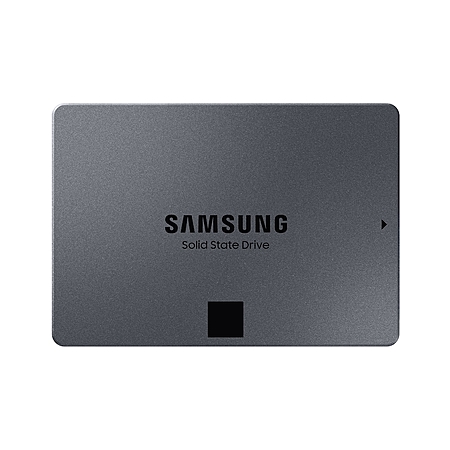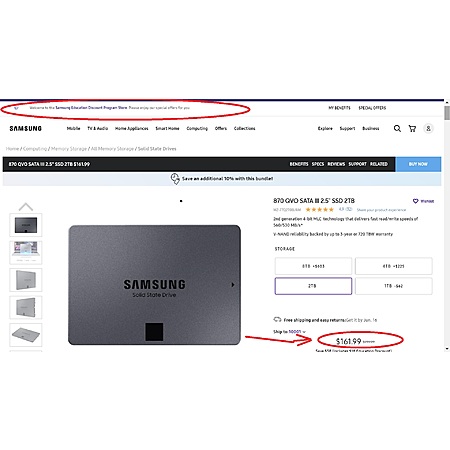Samsung.com offers
Eligible Samsung Education / Employee Discount Customers:
2TB Samsung 870 QVO Series 2.5" MLC V-Nand Internal Solid State Drive (MZ-77Q2T0B/AM) on sale for
$161.99 when you
follow instructions below. Shipping is free.
Thanks community member
FrozenBeer for sharing this deal
Deal Instructions:
- Sign in with your eligible Samsung account that qualifies for Samsung Education or Employee Perks Program (EPP) Discounts
- EDU Discount Members: Click here while signed-in to activate your EDU discount
- EPP Discount Members: Click here while signed-in to activate your EPP discount
- Click here for 2TB Samsung 870 QVO Series 2.5" MLC V-Nand Internal Solid State Drive
- Add to cart
- Proceed to checkout
- Your total will be $161.99 + free shipping.
About the Product:
- 2TB capacity
- Samsung 4-Bit MLC V-NAND
- Up to 560 MBps Max Sequential Read Speeds
- Up to 530 MBps Max Sequential Write Speeds
- 2.5" SATA Form Factor
- Improved random access speed/sustained performance







Leave a Comment
Top Comments
Because of the finer gradations of voltages at higher bit counts, it's slower to write. You have to be more careful placing the proper charge in the cell, and reading it back. Sometimes they even resort to reading it multiple times, and averaging the result to get the "correct" voltage measurement.
Because the charge slowly leaks out over time, the voltage gradually drops, eventually resulting in data loss. The more bits per cell, the smaller a drop before the data is lost. And the shorter the longevity of the data (unless the drive regularly refreshes the charge, which decreases the lifespan of the cell).
These are all consequences of using more voltage levels per cell. Nothing to do with the chips themselves.
Note that this puts these high-capacity QLC and PLC SSDs between a rock and a hard place. They're too slow for enthusiast use (unless you do a ton of SLC buffering). And they have poor reliability for long-term storage. So if you don't want to use them if you need to fast data access, and you don't want to use them if you need to write a little data and leave it there a long time, what exactly are you supposed to use them for? The caching performance is gonna have to be stellar, or they're going to have to prove its long duration endurance for QLC to be accepted.
The cost savings is not that big a deal either.
Say SLC costs $100 per TB of flash cells (NAND)
MLC would be $50, a $50 savings per GB compared to SLC
TLC would be $33, a $17 savings per GB compared to MLC
QLC would be $25, an $8 savings per GB compared to TLC
PLC would be $20, a $5 savings per GB compared to QLC
QLC is pretty close to the point where I would just rather pay the extra $8 (about $15 at retail) for the better speed and reliability of TLC. (The endurance issues with TLC have largely been canceled out by increases in drive size. A 1 TB SSD has 4x the write endurance of a 250 GB SSD, 8x that of a 125 GB SSD. Maybe that might be a niche for QLC in a decade, when a 10 TB SSD costs $100, and endurance is a non-issue.)
44 Comments
Sign up for a Slickdeals account to remove this ad.
Sounds like they don't have much faith in their drives, why should we?
Sounds like they don't have much faith in their drives, why should we?
Our community has rated this post as helpful. If you agree, why not thank Solandri
Because of the finer gradations of voltages at higher bit counts, it's slower to write. You have to be more careful placing the proper charge in the cell, and reading it back. Sometimes they even resort to reading it multiple times, and averaging the result to get the "correct" voltage measurement.
Because the charge slowly leaks out over time, the voltage gradually drops, eventually resulting in data loss. The more bits per cell, the smaller a drop before the data is lost. And the shorter the longevity of the data (unless the drive regularly refreshes the charge, which decreases the lifespan of the cell).
These are all consequences of using more voltage levels per cell. Nothing to do with the chips themselves.
Note that this puts these high-capacity QLC and PLC SSDs between a rock and a hard place. They're too slow for enthusiast use (unless you do a ton of SLC buffering). And they have poor reliability for long-term storage. So if you don't want to use them if you need to fast data access, and you don't want to use them if you need to write a little data and leave it there a long time, what exactly are you supposed to use them for? The caching performance is gonna have to be stellar, or they're going to have to prove its long duration endurance for QLC to be accepted.
The cost savings is not that big a deal either.
- Say SLC costs $100 per TB of flash cells (NAND)
- MLC would be $50, a $50 savings per GB compared to SLC
- TLC would be $33, a $17 savings per GB compared to MLC
- QLC would be $25, an $8 savings per GB compared to TLC
- PLC would be $20, a $5 savings per GB compared to QLC
QLC is pretty close to the point where I would just rather pay the extra $8 (about $15 at retail) for the better speed and reliability of TLC. (The endurance issues with TLC have largely been canceled out by increases in drive size. A 1 TB SSD has 4x the write endurance of a 250 GB SSD, 8x that of a 125 GB SSD. Maybe that might be a niche for QLC in a decade, when a 10 TB SSD costs $100, and endurance is a non-issue.)Sign up for a Slickdeals account to remove this ad.
Sounds like they don't have much faith in their drives, why should we?
Because of the finer gradations of voltages at higher bit counts, it's slower to write. You have to be more careful placing the proper charge in the cell, and reading it back. Sometimes they even resort to reading it multiple times, and averaging the result to get the "correct" voltage measurement.
Because the charge slowly leaks out over time, the voltage gradually drops, eventually resulting in data loss. The more bits per cell, the smaller a drop before the data is lost. And the shorter the longevity of the data (unless the drive regularly refreshes the charge, which decreases the lifespan of the cell).
These are all consequences of using more voltage levels per cell. Nothing to do with the chips themselves.
Note that this puts these high-capacity QLC and PLC SSDs between a rock and a hard place. They're too slow for enthusiast use (unless you do a ton of SLC buffering). And they have poor reliability for long-term storage. So if you don't want to use them if you need to fast data access, and you don't want to use them if you need to write a little data and leave it there a long time, what exactly are you supposed to use them for? The caching performance is gonna have to be stellar, or they're going to have to prove its long duration endurance for QLC to be accepted.
The cost savings is not that big a deal either.
- Say SLC costs $100 per TB of flash cells (NAND)
- MLC would be $50, a $50 savings per GB compared to SLC
- TLC would be $33, a $17 savings per GB compared to MLC
- QLC would be $25, an $8 savings per GB compared to TLC
- PLC would be $20, a $5 savings per GB compared to QLC
QLC is pretty close to the point where I would just rather pay the extra $8 (about $15 at retail) for the better speed and reliability of TLC. (The endurance issues with TLC have largely been canceled out by increases in drive size. A 1 TB SSD has 4x the write endurance of a 250 GB SSD, 8x that of a 125 GB SSD. Maybe that might be a niche for QLC in a decade, when a 10 TB SSD costs $100, and endurance is a non-issue.)Because of the finer gradations of voltages at higher bit counts, it's slower to write. You have to be more careful placing the proper charge in the cell, and reading it back. Sometimes they even resort to reading it multiple times, and averaging the result to get the "correct" voltage measurement.
Because the charge slowly leaks out over time, the voltage gradually drops, eventually resulting in data loss. The more bits per cell, the smaller a drop before the data is lost. And the shorter the longevity of the data (unless the drive regularly refreshes the charge, which decreases the lifespan of the cell).
These are all consequences of using more voltage levels per cell. Nothing to do with the chips themselves.
Note that this puts these high-capacity QLC and PLC SSDs between a rock and a hard place. They're too slow for enthusiast use (unless you do a ton of SLC buffering). And they have poor reliability for long-term storage. So if you don't want to use them if you need to fast data access, and you don't want to use them if you need to write a little data and leave it there a long time, what exactly are you supposed to use them for? The caching performance is gonna have to be stellar, or they're going to have to prove its long duration endurance for QLC to be accepted.
The cost savings is not that big a deal either.
- Say SLC costs $100 per TB of flash cells (NAND)
- MLC would be $50, a $50 savings per GB compared to SLC
- TLC would be $33, a $17 savings per GB compared to MLC
- QLC would be $25, an $8 savings per GB compared to TLC
- PLC would be $20, a $5 savings per GB compared to QLC
QLC is pretty close to the point where I would just rather pay the extra $8 (about $15 at retail) for the better speed and reliability of TLC. (The endurance issues with TLC have largely been canceled out by increases in drive size. A 1 TB SSD has 4x the write endurance of a 250 GB SSD, 8x that of a 125 GB SSD. Maybe that might be a niche for QLC in a decade, when a 10 TB SSD costs $100, and endurance is a non-issue.)Reference https://slickdeals.net/f/15048901-crucial-mx500-2tb-sata-ssd-153-99?src=SiteSear
Sign up for a Slickdeals account to remove this ad.
https://slickdeals.net/f/15071611-500gb-samsung-980-nvme-ssd-66?p=147664354#
https://slickdeals.net/f/15064222-leven-ssd-2tb-3d-nand-tlc-sata-iii-6-gb-s-internal-solid-state-drive-for-164-99-f-s?p=147632680#p
https://slickdeals.net/f/15061525-samsung-870-evo-series-2-5-500gb-sata-iii-v-nand-internal-solid-state-drive-ssd-for-59-99-f-s?p=147573724#p
https://slickdeals.net/f/15046366-1tb-sk-hynix-gold-p31-nvme-gen3-m-2-2280-internal-ssd-114-74?p=147445909#
Leave a Comment